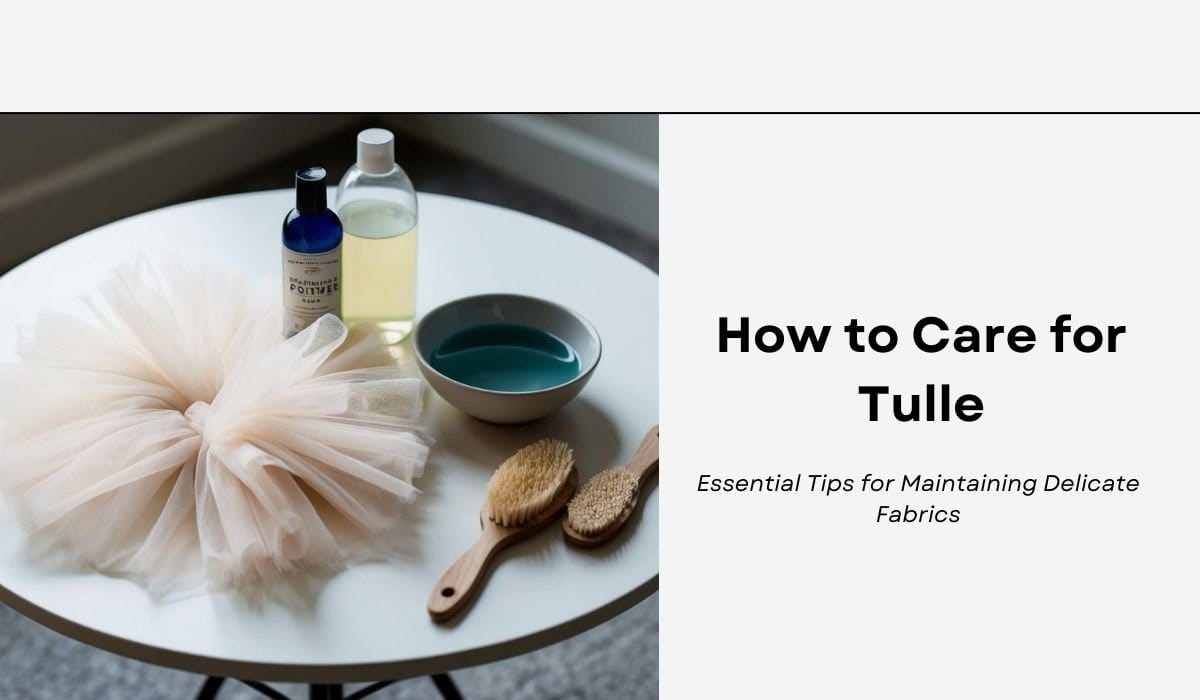From Cleaning to Storage: Your Complete Guide to Preserving Tulle’s Ethereal Beauty
Tulle, the delicate fabric known for its ethereal beauty, requires special care to maintain its charm. Many people feel unsure about how to properly clean and store tulle garments. With the right techniques, you can keep your tulle items looking lovely for years to come.
To care for tulle, hand-wash it gently in cold water with mild detergent. Avoid wringing or twisting the fabric, as this can damage its delicate structure. For tougher stains or intricate items, professional cleaning may be the best option. Proper storage is equally important – hang tulle garments in a cool, dry place away from direct sunlight to prevent yellowing and maintain their shape.
By following these simple care instructions, you can ensure your tulle dresses, veils, and other items stay in top condition. Whether you’re preserving a cherished wedding gown or caring for everyday tulle pieces, these tips will help you enjoy the beauty of this fabric for many occasions to come.
On This Page
Key Takeaways
- Gentle hand-washing and proper storage preserve tulle’s beauty
- Professional cleaning is best for intricate or heavily stained items
- Regular care prevents yellowing and maintains the fabric’s shape
Understanding Tulle
Tulle is a delicate, sheer fabric with a distinctive net-like appearance. It comes in various materials and finds use in many fashion applications.
Types of Tulle
Tulle comes in several types, each with unique traits. Silk tulle is soft and luxurious, often used in high-end gowns. Nylon tulle is strong and resilient, making it ideal for ballet tutus and veils.
Polyester tulle is affordable and widely used in craft projects. Illusion tulle has a fine mesh that creates a barely-there look, perfect for bridal veils.
Each type of tulle has different care needs. Silk requires gentle hand washing, while nylon and polyester can often be machine washed on a delicate cycle.
Displaying Tulle’s Ethereal Quality
Tulle’s lightweight nature allows it to float and move gracefully. This ethereal quality makes it a favourite for wedding dresses and formal wear.
To showcase tulle’s airy charm:
- Use multiple layers for volume
- Drape it loosely for a soft, flowing effect
- Pair it with stiffer fabrics for contrast
Proper lighting can enhance tulle’s translucent beauty, creating a dreamy, romantic atmosphere.
Tulle in Fashion Industry
The fashion industry relies heavily on tulle for its versatility and aesthetic appeal. Designers use it to add volume to skirts, create delicate overlays, and craft intricate embellishments.
Tulle appears in:
- Bridal wear (veils, gowns)
- Ballet costumes
- Evening dresses
- Accessories (hair pieces, bows)
Its ability to hold shape while remaining light makes it ideal for creating dramatic silhouettes. Tulle can be dyed, printed, or embroidered, offering endless creative possibilities for fashion designers.
Pre-Washing Considerations
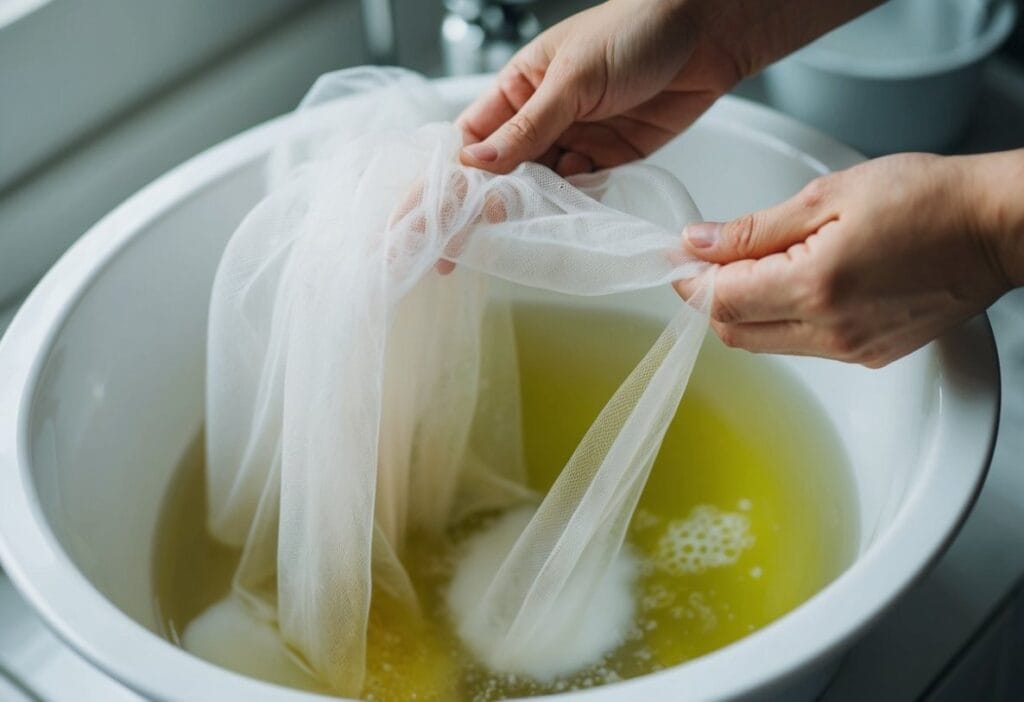
Before washing tulle, it’s crucial to check care labels and select the right detergent. These steps help prevent damage and ensure proper cleaning.
Reading Care Labels
Care labels provide vital info for tulle care. Check the label for washing instructions. Some tulle can be machine washed on a delicate cycle, while others need hand washing.
Look for symbols that show water temperature and drying methods. If the label says ‘dry clean only’, take it to a pro.
For items without labels, err on the side of caution. Treat the tulle as delicate fabric.
Choosing the Right Detergent
Picking the right detergent is key for tulle care. Use a mild detergent made for delicate fabrics. Harsh chemicals can damage tulle fibres.
Liquid detergents are often better than powders. They dissolve easily and leave less residue. Avoid detergents with bleach or strong fragrances.
For extra gentleness, try baby shampoo or wool wash. These are designed for sensitive fabrics.
Use only a small amount of detergent. Too much can leave a film on the tulle, making it stiff.
Hand Washing vs Machine Washing
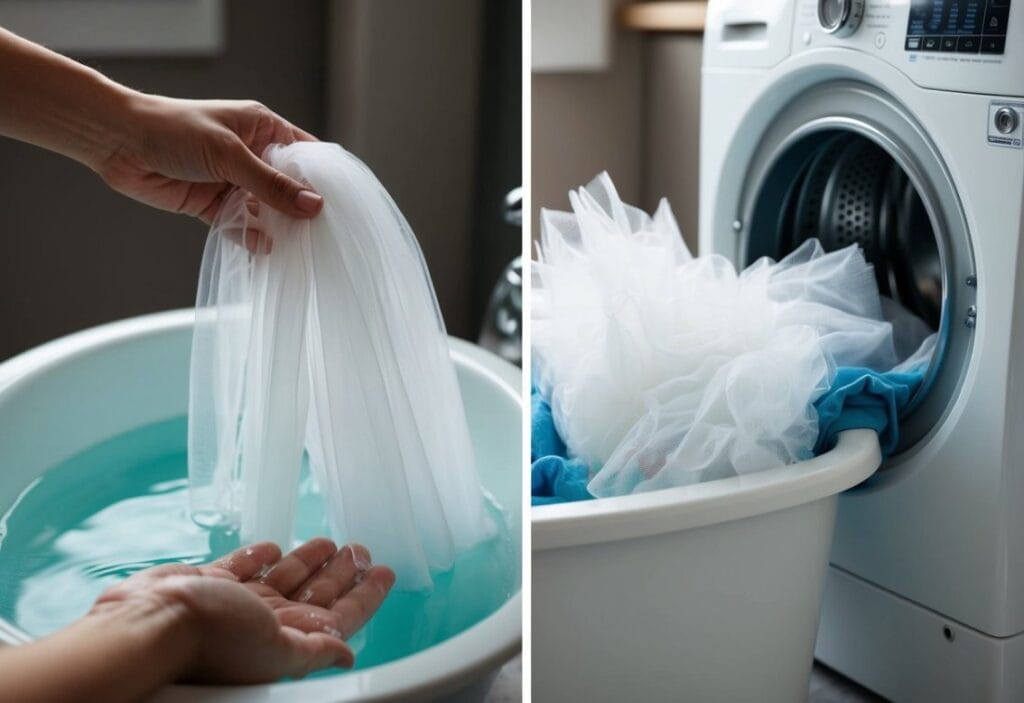
Tulle fabric requires gentle care to maintain its delicate structure. Both hand washing and machine washing can be suitable methods, depending on the specific tulle item and level of soiling.
Hand Washing Technique
Hand washing is often the safest way to clean tulle fabric. Fill a sink with cool water and add a mild detergent. Submerge the tulle item and gently swish it around. Avoid rubbing or wringing the fabric, as this can damage the delicate mesh.
Let the tulle soak for 5-10 minutes. Rinse thoroughly with cool water until all soap is removed. Gently press out excess water without twisting.
Lay the tulle flat on a clean towel to dry. Reshape as needed while damp. Keep away from direct heat or sunlight.
Machine Washing Instructions
For sturdier tulle items, machine washing is possible with care. Use a mesh laundry bag to protect the fabric from snagging or tearing.
Select a delicate cycle with cold water. Use a gentle detergent and avoid fabric softeners. Set the spin cycle to low or skip it entirely to prevent crushing the tulle.
Remove the item promptly after washing. Gently reshape and lay flat to dry. Never tumble dry tulle, as the heat can damage the fabric.
For heavily embellished or very delicate tulle, professional dry cleaning may be the best option to ensure proper care.
Drying and Ironing

Proper drying and ironing techniques are crucial for maintaining the beauty and shape of tulle fabrics. Taking care during these steps will help preserve the delicate material and keep it looking its best.
Air-Drying Procedure
To air-dry tulle, hang it in a well-ventilated area away from direct sunlight. Use padded hangers to prevent creases and damage to the fabric. For large pieces, lay them flat on a clean, dry towel.
Avoid wringing or twisting the tulle, as this can cause permanent damage to the fibres. Instead, gently squeeze out excess water.
If using a dryer is necessary, select the lowest heat setting and remove the tulle promptly to prevent wrinkles from setting.
Safe Ironing Methods
Ironing tulle requires caution to avoid melting or damaging the delicate fabric. Set the iron to the lowest heat setting and wait for it to warm up fully.
Place a pressing cloth or clean white towel over the tulle before ironing. This protective layer helps prevent direct contact between the iron and the fabric.
Gently hover the iron about 2.5 cm above the tulle, using the steam function to relax wrinkles. For stubborn creases, lightly press the iron on the protected area for a few seconds.
Always test a small, inconspicuous area first to ensure the fabric can withstand the heat without damage.
Stain Removal
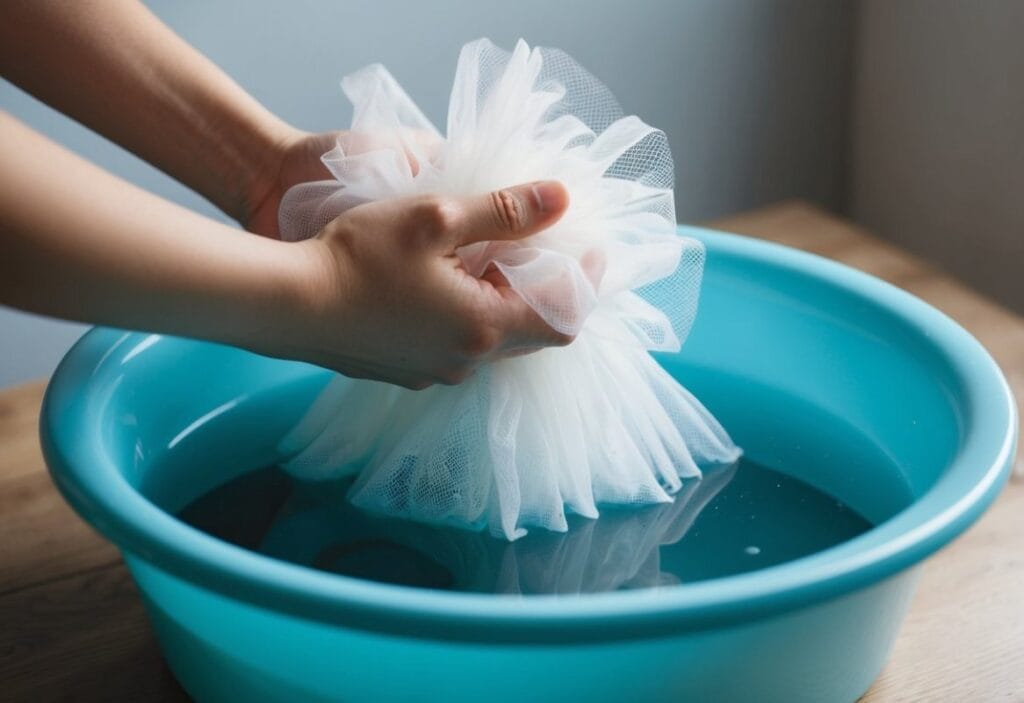
Removing stains from tulle requires gentle techniques and the right products. Quick action and proper methods can save your delicate tulle from permanent damage.
Mild Stain Remover Usage
To tackle stains on tulle, a mild stain remover is essential. Mix 1 tablespoon of baking soda, 4 tablespoons of mild dish soap, and 8 tablespoons of hydrogen peroxide to create a gentle solution.
Apply this mixture to the stain using a soft cloth. Dab gently, avoiding rubbing which can damage the fabric. Rinse thoroughly with cool water.
For stubborn marks, OxiClean offers a gentle stain remover suitable for tulle. Always test any product on a hidden area first.
Alternative Stain Removal Solutions
For light stains, try blotting with cold water. This simple method can be effective for fresh, water-based marks.
Club soda is another reliable option. Its bubbles can help lift the stain from the delicate fabric. Apply it gently and blot with a clean, white cloth.
For oily stains, a small amount of dish soap can work wonders. Apply a tiny drop to the stain, gently work it in, and rinse thoroughly with warm water.
Remember, always act quickly when dealing with stains on tulle. The sooner you address the problem, the better your chances of successful removal.
Professional Cleaning Options
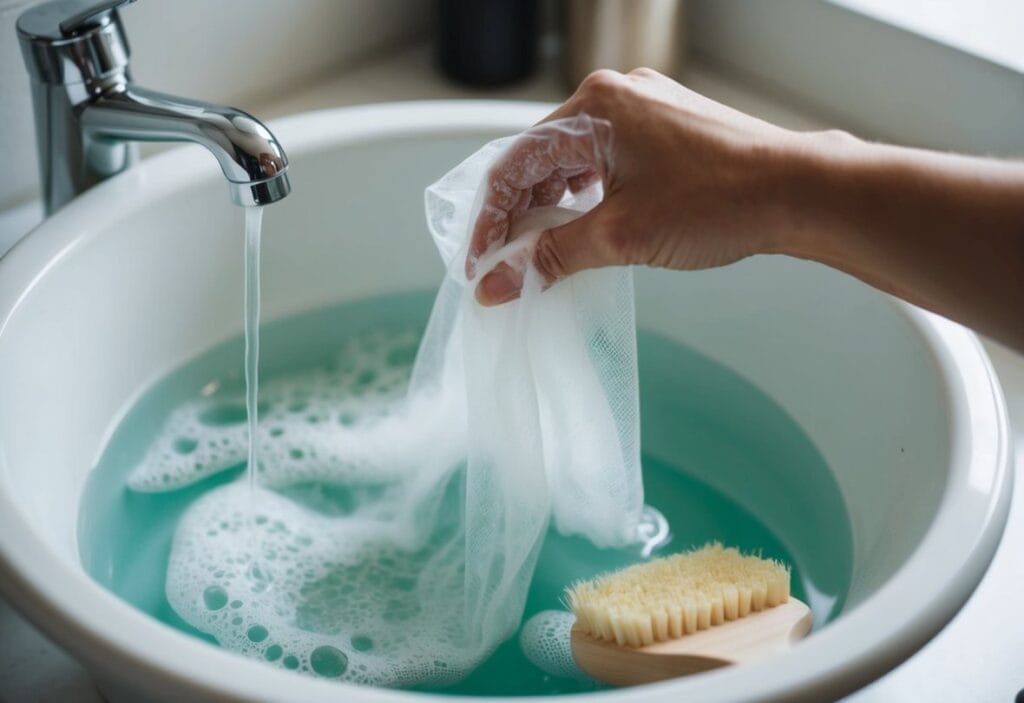
Professional cleaning can be the best choice for delicate tulle items. It helps protect the fabric and removes tough stains safely.
When to Choose Dry Cleaning
Dry cleaning is ideal for tulle garments with intricate details or embellishments. Professional dry cleaning is recommended for wedding dresses, special occasion gowns, and high-value tulle items.
It’s also a good option for stubborn stains that won’t come out with hand washing. Dry cleaning can effectively remove oil-based marks and set-in dirt without damaging the delicate fabric.
For tulle mixed with other materials, dry cleaning ensures each fabric type is treated properly. This method is gentler than machine washing and helps maintain the shape and structure of tulle garments.
Selecting a Dry Cleaner
Choose a dry cleaner with experience in handling delicate fabrics. Ask about their methods for cleaning tulle specifically.
Look for cleaners who offer:
- Hand-cleaning options
- Specialised solvents for delicate materials
- Experience with wedding dresses or formal wear
It’s crucial to communicate the garment’s specific needs. Tell the cleaner about any stains, embellishments, or special care instructions.
Before committing, ask for references or look for reviews from other customers who’ve had tulle items cleaned. A reputable cleaner will be happy to discuss their process and answer questions.
Storing Tulle Garments
Proper storage keeps tulle garments in top shape. The right techniques prevent wrinkles, snags, and damage.
Correct Folding and Hanging
Hanging is best for tulle dresses and skirts. Use padded hangers to avoid pressure marks. Wrap the hanger in soft fabric for extra care.
For folding, lay the tulle flat. Gently fold it, avoiding sharp creases. Place acid-free tissue between layers to reduce friction.
Store tulle items in a cool, dry place. Keep them away from direct sunlight to prevent fading.
Using Tissue Paper for Protection
Acid-free tissue paper is a tulle’s best friend. It guards against moisture and dust.
Layer tissue paper between folds of tulle garments. This stops colours from transferring and reduces creasing.
For long-term storage, wrap the entire item in tissue. Then place it in a breathable fabric bag or box.
Change the tissue paper yearly. This stops acid build-up that can harm the tulle.
Tulle Repairs and Alterations
Tulle can sometimes tear or require adjustments. With the right techniques, you can fix damage and alter tulle garments to fit properly.
Dealing with Tears and Holes
Small tears in tulle can be mended with careful stitching. Use a sharp needle and thread that matches the tulle colour. Gently pull the edges of the tear together and sew with tiny stitches.
For larger holes, a patch may be needed. Cut a piece of tulle slightly larger than the damaged area. Place it behind the hole and stitch around the edges to secure it.
Tulle adhesive can work for quick fixes. Apply a small amount to the tear edges and press them together. Let it dry completely before wearing the garment.
Be extra careful when repairing tulle veils. Their delicate fibres require a very gentle touch. Use a fine needle and minimal stitching to avoid further damage.
Adjusting Tulle Clothing Sizes
Tulle garments can often be altered to improve fit. To take in a tulle skirt, create small pleats or gathers at the waistband. Stitch these in place by hand or machine.
To shorten tulle, carefully trim the excess length with sharp scissors. Leave a small hem allowance. Fold this under and stitch with a fine needle and thread.
Adding fullness to a tulle skirt is simple. Sew additional layers of tulle underneath the existing ones. This creates more volume without changing the outer appearance.
For major alterations, consult a professional seamstress. They have the skills to work with tulle’s delicate fibres without causing damage.
Frequently Asked Questions
Caring for tulle requires special attention to preserve its delicate nature. Proper washing, wrinkle removal, and handling techniques are essential for maintaining tulle garments and accessories.
How can one remove wrinkles from a tulle wedding veil?
Steaming is the most effective method for removing wrinkles from a tulle wedding veil. Hold a handheld steamer about 15 cm away from the fabric and gently pass it over the wrinkled areas. Avoid direct contact with the tulle to prevent damage.
For stubborn wrinkles, hang the veil in a steamy bathroom for 15-20 minutes. The moisture will help relax the fabric.
What is the safest method to wash a tulle skirt?
Hand-washing is the safest way to clean a tulle skirt. Fill a basin with cool water and add a small amount of mild detergent. Gently submerge the skirt and swish it around, avoiding rubbing or wringing.
Rinse thoroughly with cool water until all soap is removed. Gently squeeze out excess water without twisting the fabric. Lay the skirt flat on a clean towel to air dry.
Is it possible to machine wash tulle garments without causing damage?
Machine washing tulle garments is possible but risky. If necessary, use a mesh laundry bag and select the gentlest cycle with cold water. Add a mild detergent suitable for delicates.
Avoid using fabric softeners or bleach. Remove the garment promptly after washing and lay it flat to dry. Machine washing may shorten the lifespan of tulle items.
What precautions should be taken when dry cleaning tulle articles?
When dry cleaning tulle, inform the cleaner about the fabric’s delicate nature. Request gentle cleaning methods and avoid heavy pressing.
Ask for hand-pressing or steaming instead of machine pressing. Ensure the dry cleaner has experience with delicate fabrics like tulle to prevent damage.
Will ironing tulle fabric harm its delicate structure?
Direct ironing can damage tulle’s delicate structure. If ironing is necessary, use the lowest heat setting and place a pressing cloth between the iron and the tulle.
Steam ironing is a safer alternative. Hold the iron slightly above the fabric, allowing the steam to relax the fibres without direct contact.
How should tulle dresses be handled to maintain their shape?
Store tulle dresses hanging on padded hangers to maintain their shape. Avoid folding, which can create permanent creases.
Cover the dress with a breathable garment bag to protect it from dust and snags. For long-term storage, stuff the bodice with acid-free tissue paper to help maintain its form.
Related Post: 20 Facts About Tulle: Unveiling the Secrets of This Versatile Fabric

